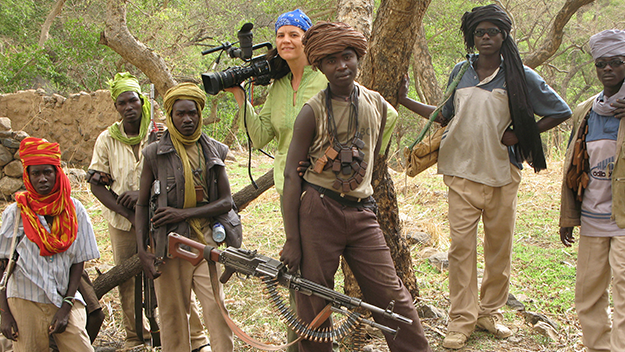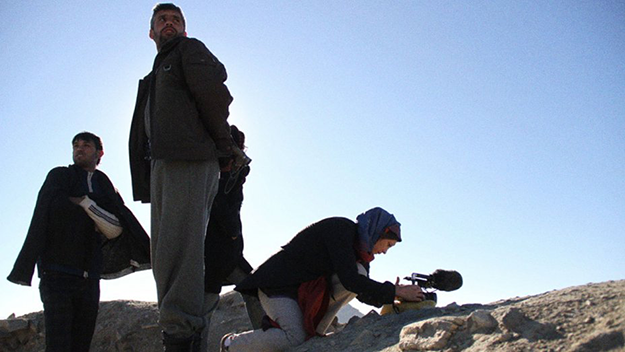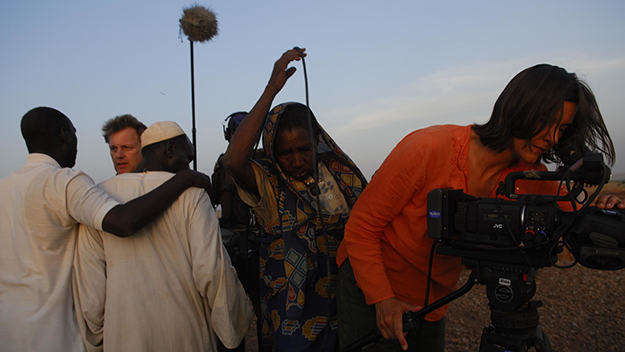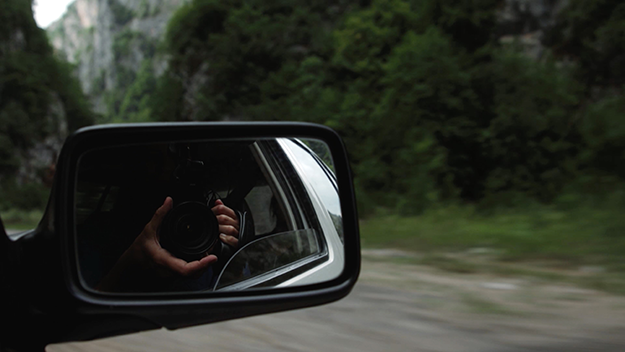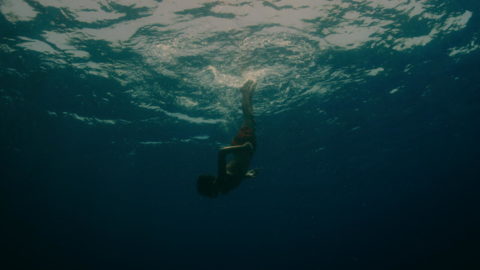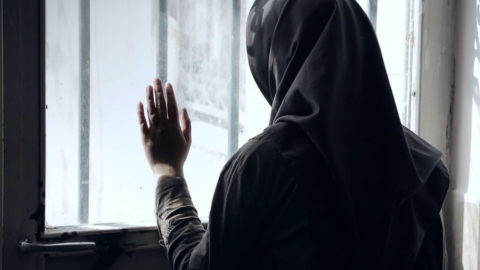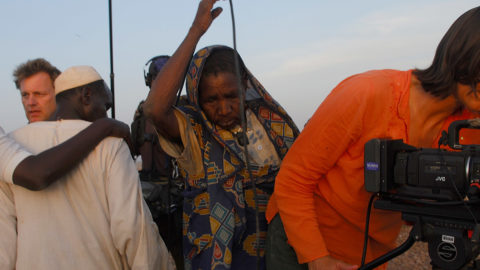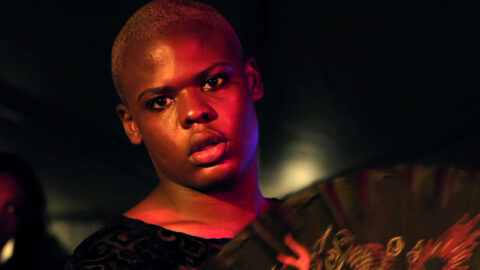ND/NF Interview: Kirsten Johnson
On a panel at the True/False Film Festival, veteran documentary cinematographer Kirsten Johnson recalled balking at a director’s request to film a tracking shot of Sudanese men in a refugee camp. It was, she said, a gesture that would turn them into an anonymous mass, and she wanted to shoot them as individuals. She won that battle, but acknowledged that even the most conscientious of nonfiction filmmakers fall short of their own ideals. “I betray my own moral imperative over and over again,” she admitted, “which you have to do to be able to film things.”
Nearly all of the material in Cameraperson, which marks Johnson’s debut as a director, was shot in the course of making other films—more than two dozen of them, including CITIZENFOUR, Fahrenheit 9/11, The Oath, and Two Towns of Jasper. But the more you watch, the more you can feel her constant presence, even when her hand isn’t reaching into frame to de-streak a windshield. A guiding intelligence links the movie’s images, and a fierce compassion, a trait more easily pondered when it’s not swept away on the tide of an overarching narrative.
Concentrating on what Johnson calls “images that marked me,” Cameraperson strips away exposition, providing only the location where footage was shot—and, in the case of one outtake from CITIZENFOUR, even that is undisclosed. It’s arranged instead according to the logic of memory, conveying something of what it must be like to be inside the head of someone who’s captured so many extraordinary—and, in some cases, traumatizing—images over the course of a long and still active career. (Cameraperson premiered at Sundance alongside two more Johnson-shot documentaries—Trapped and Audrie & Daisy—and contains footage from others as yet unfinished.) Movies are often spoken of as a way to see the world through another’s eyes, but Cameraperson engages the whys of seeing as well as the whats; its vision is a gift, and also a responsibility.
When we first start watching movies, whether they’re fiction or documentary, we don’t think about them as constructed objects. They just exist. Do you remember when you realized that movies were actually made by people, and that you could be one of them?
I had this brother who could find things. He could find fossils. He has since become a paleobotanist, so he finds fossil plants. We would go to the beaches of Washington state, and he would knock apart a concretion and find things inside. And I would be hitting it with a hammer and just come up with little bits. For a long time, I couldn’t figure out how he could find things and I couldn’t. He loved art, but he was always finding the most extraordinary things in nature, and so I had this sense that making things will always be inadequate, and I’m inadequate at making things and finding things. There was a very long period of time where I could see what other people had made, but it seemed fully formed to me.
It was a very late experience, and I think that I carried that with me, even in my shooting. Part of it was this overwhelming sense of, you missed it, that wasn’t the lens to get it on, you were out of focus—that was the prevailing struggle. But then, it became somehow, someone can do this, and if I keep trying, somehow I will have moments of being able to do this. It’s always felt very much like fragments of actually clicking into where it feels like cinema is being made when I am shooting. But, also late, I have come to the understanding of how much is happening in that struggle. It feels like even with this film, I don’t really quite know how it was made; it was such a collaboration, and such an odd struggle, and then it appeared as something that I don’t recognize. All of those things make me ask new questions about making things. What I do know is true about this film is that it came from a very profound need, and I kept addressing that need until it had an answer.
How long did you work on Cameraperson?
I think it started in 2009 when I went to Afghanistan and I worked on this film [The Blind Eye] that was to be about something else. In 2012, when I’d finished editing that film and showed it to the young woman who was in it, she said: “You can’t use this footage.” From that point forward, I started asking all of these really strong questions around permission and complicity. But even that film was a search to understand vision, invisibility, representation—and the role of time in all of this. When I was filming with her, I had complicity, I had consent. And then at this moment in time, when we’ve edited, the consent is gone. Would she want in the future to see who she was? You could imagine yes, maybe, but you can’t know that. I think anyone who holds a camera is involved in that battle at all times. Someone sees you shooting—do you pull away, do you keep shooting, what happens in that moment? You experience that every day that you’re filming. It’s been a preoccupation of mine from the minute I picked up a camera.
You didn’t start out wanting to make films, though. Your original impulse was to become a critical theorist.
I came up in that first wave of identity politics [at Brown University in the 1980s]. I discovered the international world, and I was really interested in South African apartheid struggles. I was really freaked out by my whiteness, and felt like, “Can I talk? What can I say? We need to let other people talk.” I was wholly unaware, I would say, of being a woman in this whole schema of things.
I saw the films of Djibril Diop Mambéty, like Touki Bouki, and I saw Sembène films, and my mind was kind of blown. I just wanted to see more of something so different. So I got myself to Dakar, but I got there 15 years too late. All the filmmakers I met hadn’t made films in years. It was all happening in Ouagadougou. But I went to Fespaco, and it was this crazy revelation where I saw all of these West African filmmakers who got to make one film and then never got to make another film. And then there were all of these people who sort of lived off of the idea of African cinema, and it was all these white women in their forties and fifties who were having affairs with different African filmmakers. I remember thinking: “Oh my God, this is not going to be me.” So where with theory, it felt like somehow I could escape from the dilemmas of identity politics by supporting other people’s work and talking about it, suddenly I was like, this may be even trickier territory.
I had also by that time picked up a camera and filmed with these World War I Senegalese veterans, and then I got to work on this feature film, Niiwam, and it was like: “I love this. I want to do this.” Language was so tricky at that moment in history. To even speak was so complicated, and then I was just stripped to nothing. I couldn’t speak French. I couldn’t speak Wolof. No one spoke English. And suddenly it was just about my dynamics with people. I learned to trust people without being able to communicate, and all of the intellectualism and all of the words were gone. That seems really fundamental to me in becoming a cameraperson, losing verbal language and coming up with ways of seeing and reading people on visual cues. When I went to film school [at La Fémis] in France, it was the same thing. I was out of my league on a verbal level, but I was tying to survive by my wits, visually. Working on the Derrida film was very much that. I was way out of my league, verbally.
You’ve said that shooting Derrida was a major milestone for you.
Amy Ziering came looking for someone who could speak French and English. I was so in awe of him. I really wanted him to know I had a brain, and I was really chatty. He was pretty funny, and I was trying to charm him, and I remember getting out of the car after driving into the city with him, and Amy whispered: “Stop talking.”
Very shortly after that, we were in his home and he needed to really think. He wanted us out, and Amy was begging him to let us stay, and he said, Kirsten can stay by herself with a camera if she does not say a word. So there I was in his home for the next eight hours and I didn’t speak. And it was so profound for me. I started to realize that all of my thinking I could communicate with my shooting, and enough was going on with him that you could actually have visual ideas that spoke to what he was doing. So he got lost in his thing and I got lost in my thing, and it was this turning point of what you can discover once you do that.
One of the surprises in Cameraperson is how present in it you are, even though you’re almost never on camera. In one of the earliest shots, we hear you gasp as a lightning bolt cuts across the sky. You would think a cinematographer would train themselves to keep silent, although in most cases the sound in the film is being recorded separately and not by your camera.
There is a real thing about when you can talk. Sometimes you transgress, like that moment where I ask the older woman in Bosnia, has she always been such a great dresser—I couldn’t bear anymore the fact that we were asking her all these questions about the horror [of war crimes]. Sometimes that happens, where I know we have the material that’s needed for the film and I see where we’re taking the person, and I just can’t restrain myself. That’s not within the hierarchy of what’s supposed to happen. It’s not appropriate, but sometimes I’ll feel like we’re riding some train too hard, and I’ll just be like: “Can’t we just go sideways with it?” And I’ll throw a monkey wrench into things.
Especially when you’re dealing with politically sensitive material and subjects who may face recrimination, the context in which the material you shoot appears is critically important. But Cameraperson deliberately strips much of that context away: you don’t tell us what films the footage was shot for, only the location where it was shot. What kinds of conversations did you have with the original directors about repurposing material for your film?
It did feel deeply freeing, because so many of the films I’ve worked on are coming from a place of having a really conscientious human rights objective. With the abortion footage from Trapped, that’s not necessarily the footage that you would put in a film in which you’re advocating a pro-choice position, to have her say, if I didn’t do this abortion I would give this baby up for adoption. That’s murky territory. But it is, in fact, the very powerful truth of this person. In that case, Dawn [Porter] was completely like: “No problem.” But in the case of Two Towns of Jasper, Whitney [Dow] and Marco [Williams] were very concerned about how the story of James Byrd was contextualized, and what it means to have Whitney asking “Can we see those photos” [of Byrd’s body after he was dragged to death] without having the context of how they handled that material in the actual film. We had very long, super-interesting conversations about it, and I think it was a stretch for all of us at a certain point to say “Is it okay to do this,” because it’s such loaded material.
When the prosecutor balks at showing you the photos of Byrd’s body on camera, it’s like the moment in Grizzly Man when Werner Herzog listens to the audio of Timothy Treadwell being mauled to death. The filmmakers are experiencing it, but the audience is spared.
It was totally that for me. The thing that I said to Whitney and Marco was: “I saw those photos, and they are indelible, traumatizing images that I cannot get out of my mind.” Whitney and Marco saw those photos, and we all have that knowledge inside of us, and other knowledge that came from being in that place. Some of it makes it into the film, some of it doesn’t. What was really fascinating to me in all these discussions with the directors is that the material that I had to work with the longest in order to figure out how I was going to deal with it in the film, like the baby in Nigeria scene, like The Two Towns of Jasper, that was the material that I had to spend the longest time talking with the directors about. It’s just really loaded material to encounter in your life. Everybody had real struggle around figuring out how to represent that.
What was the source for the Nigerian footage of a newborn baby while awaiting the arrival of much-needed oxygen?
It’s from a film called The Edge of Joy. She [Dawn Sinclair Shapiro] ended up using a lot more really explicit footage even than I used, and it had a lot of context about the Nigerian health care system. But my emotional experience of living through that was not present in her film, in any way. It was one of the biggest burdens I felt like I had carried in the course of my life of being a cameraperson.
In Cameraperson’s opening text, you refer to the images you’ve chosen as representations of “moments that marked me.” What does that mean?
I think that I’m a different person, and I don’t even know how, because of shooting those things. The whole thing around forgetting—what can you forget, what are you allowed to forget, what shouldn’t you forget—is a big question for me. The Nigeria footage, for example. It would often come to mind as this blurry image of this midwife’s face, but it wasn’t even just her face. It was two midwives I had put together in my mind. I knew the things that had happened there: I could consciously say: “A child died.” I knew that. But when I asked for the footage from the director and I sat down with Judy Karp, who had done the sound with me, what was crazy was that I knew everybody. I knew every face. And it was so clear that the blurry face was a way my brain had created for protecting me. The James Byrd book was the same way. I know what’s in that book, but the closed book is what stays in my mind. I’m really interested in that process. What is my brain up to, that I’m holding so many different experiences, and I’ve got caps on them, somehow—the cap of an image, blocking myself from knowing all these other images that I know.
That’s especially true with the Bosnian footage from I Came to Testify. It’s about the systematic use of rape as a tool of ethnic cleansing in the Balkans, and yet you say in Cameraperson that until you returned to Foča, you couldn’t remember what the movie’s subject was.
That’s the crazy one. That was really shocking to me. I literally thought it was a film about blueberries. When I showed it to Amanda [Laws], my editor, she was like: “Why didn’t you tell me this was a film about rape?” And I was completely stunned. I had no idea. You become very interested in how memory and forgetting works when you have a parent with Alzheimer’s.
I’m not a combat journalist, and yet I know all these people—I knew Tim Hetherington, I know Lynsey Addario. Lynsey and I spent time together in Darfur, and then she was off to another place after that. I was like: “How are people processing this?” It’s funny, because it was “How are people,” not “How am I?” All I’m doing is dealing with the aftermath and poverty, but just because you’re not seeing people get shot all the time, it doesn’t mean you’re not experiencing it. So that was really fascinating to me at a certain point. I’d done a lot of thinking about how other people were handling it, but I had to reach some kind of saturation place inside myself.
You refer to the first version of Cameraperson, before editor Nels Bangerter came on board, as “the trauma cut.” By your own token, that distillation of the horrors you’ve witnessed on so many shoots was so dark it was virtually unwatchable.
It really was the tip of my iceberg. I was like: “This is nothing, compared to what I have seen. This is two and a half hours.” And yet. The fact that I had been rational, and had been there with an editor, thinking about how we put it together, and yet I wouldn’t have imagined it would be so traumatic—that was truly stunning. It really took me a great while to recover from. Thank God, Marilyn Ness, my producer said: “We’re going to stop editing.” Cameraperson is all the same material. It’s not like this film isn’t “the trauma cut.” There still are however many genocides in it.
I had consultations with a couple of great editors, like Jonathan Oppenheim, after that, and I sat there and talked about, what would it take to be able to experience this much feeling? I got super-interested in neurosciences, and that was also this coping mechanism. How does “the brain” process all this? I was reading tons around neuroscience and perception and how does empathy work in the brain, how does fear work in the brain. I spent a lot of time thinking structurally, taking myself away from the visceral. I was in systems.
And I told myself I wouldn’t shoot as much, too. In fact, I ended up going on this crazy shoot with Rebecca Cammisa where we snuck into a hospital and filmed a kid who was dying of cancer. And I was like: “I don’t need to be doing this right now. I shouldn’t be doing this right now.” That doesn’t mean I’m not going to do this forever, but I’m not going to pile more emotionally demanding material on top of this. That was, I think, the first time I’ve said no to something because of its content in 20 years. It was really interesting and super compelling, and I had a really hard time saying no. That’s where I was starting to get outside of myself and see myself from a distance.
Cameraperson brings out recurring themes in the movies you’ve shot, many of which have to do with the systematic abuse of women. Have you thought about what draws you to those subjects?
I don’t think I figured it out right away. Because of where I come from historically, I was always interested in racism. Race was my thing, trying to figure out all the dilemmas of it domestically, and then internationally as I traveled. But 9/11, for me as for many people, really shifted the orientation of the word. Where I’d been thinking all about postcolonialism and African history and the African diaspora, all of a sudden it took me in this new direction. I had the experience of going to Guantanamo [for The Oath], and when I read The Looming Tower, I realized that three of the people from that book I had seen in person. I had been in the courtroom when Ali Soufan was testifying, and then to see Abu Jindal and to see Hamdan and to see these prosecutors, all of a sudden it felt like this giant puzzle that was real, and I could maybe put together some pieces. Of course, that was not true on any level. But it was the feeling of “Ah, I understand this piece, and this is locking into this piece.” So that became completely energizing.
It was an odd discovery, but to be in Muslim countries somehow evoked memories of my [Seventh Day Adventist] childhood, because of the call to prayer, the ambient presence of belief. I ended up expressing that in The Above. I started to work on those thoughts and ideas, and started to realize this is getting at something close to me.
I was always thinking about human rights questions when I was filming, so I knew that was a thematic of mine. But it’s hilarious to me how late in the game I realized, “Oh, women’s place in the world, I deeply care about that,” even though I was working with all these women directors like Gini Reticker and Abby Disney, for who that’s the primary preoccupation. I would be like, “Race, race, race,” and they’d be like, “Women, women, women.” And then at a certain point, I was like: “Oh yeah, women!” It’s really evident in my film that I’m preoccupied with what women are doing and the challenges women face. It’s not what I’m focusing on, but it’s totally there.
That goes back to the moment when you interrupt the interviewer’s questions about war crimes to ask the woman whether she’s always been such a fabulous dresser. You’re not just asking about fashion. You’re asking about survival.
And that’s something that matters to me. Where is the color in things? That was the moment where when Nels did the rough cut, I could see that I do engage with the world, that there are all these things that are so sensual and loving and tender. That was a revelation.
One of the first things we see in Cameraperson is you plucking at a stray blade of grass at the bottom of the frame. It’s clear even those minor details are important to you.
I’m always trying to frame. A lot of times, because of the limitations in nonfiction, you just have to accept what the light is. But compositionally, I’m always pushing. I worked with Raoul Peck, and he’s very rigorous about composition. I remember I’d frame a shot and then he’d slightly reframe it and I became obsessed with seeing: Can I frame it in a way that he will not reframe it? I think I did it twice in the course of hundreds of shots, but I was so satisfied. Because he was just by fractions of things making it better on an aesthetic level.
You don’t just mean that the shots in a documentary should be beautiful. It’s clear you’re thinking them through on many levels at once.
When I teach, I talk about, how are you as a cameraperson trying to find a way to express what the director is interested in? You’re trying to know what the director is interested in. I have these conversations with directors where I’m trying to come up with a list or a map of themes that are important to them. In CITIZENFOUR, Laura did the shot of Snowden through the window in Russia, but that was a shot that we had talked about. We’d filmed Julian Assange that way. We’d filmed Bill Binney that way. It was this way of thinking about surveillance, privacy—you can go into this space, you can’t go into this space. It was an idea that connected to all of these ideas that she had about these issues. And we were constantly trying to find places to play it out. That happens a lot. When I shoot, I’ll have ideas and themes in my head, and it’s not that I’m trying to make it look pretty, but I’m trying to find a way to visually express what’s intrinsic to the story or the questions.
How did you start teaching?
With The Oath, Laura and I went to the Abu Dhabi Film Festival, and I met several Syrian filmmakers there who were running this festival in Damascus called Docs Box. I sort of volunteered to them and said I would love to work with camerawomen in this place, thinking it was really women who needed support for using the camera. But then I got there and it was both men and women, and everybody was navigating this really tricky territory in each of the different countries they were from. There were people from Egypt and Tunisia and Libya, and everybody had to navigate their relationship to the police and the government and whether they could film women or not, and so we just had incredible conversations around all the issues that are fascinating to me on this front. Then I got offered to create a master class in the journalism department at NYU in visual thinking. They have many Chinese students, students from Pakistan: it’s a very international situation where I feel like we’re all asking these questions generally. What are the strategies for how we make it through and around communicating what’s going on in the world when there’s so much pressure from all sides.
CITIZENFOUR was an extraordinary experience, an atypical experience, but it really put me in solidarity with people in other parts of the world where your aesthetic choices can determine your fate. I don’t know if you saw Hooligan Sparrow at Sundance, but I got this email from Nanfu Wang that was like: “Yeah, I kept the camera rolling like you told me when the police were chasing me.” And I thought: “Yeah, but I’m not Chinese in China.” I felt like I had shared this advice with her that was coming from a place of privilege, from a place where I can get on a plane and leave the country and don’t have to come back. So that experience even more has expanded how I teach, and how much all of this is a question mark for me. I think that informed this film, too. Instead of nailing things down and thinking, “I’m going to say things about this,” it’s like, “I am going to reveal things about this,” and then let’s talk about them.
In addition to drawing on the films you’ve shot for other people, Cameraperson also includes footage of your mother, who has Alzheimer’s disease, and your twin children. How did that end up in the movie?
I’d forgotten I had any footage of my mom. I hadn’t looked at that footage since her death. That was an act, to open up that footage and look at it. The stuff with my kids I had just shot by myself. If I had rented a camera for a shoot, I would just shoot something with them. That was stuff Nels asked for: do you have anything more that’s just your life?
Is it different to shoot your mother or your children for your own use than it is to turn the camera on them knowing you might use that material for a film?
I remember I was filming my kids in the bath, and I was like, I’m filming footage of my kids naked. Where will it go? I do have a hyper-awareness around how footage can be used. You’re self-aware, even when you’re filming family, because it’s evidence of something. And you know that it’s partial evidence. On the playground, something will be so cute, and you experience this thing of, “Do I film this? Do I pull out my phone? And what am I doing to this moment to film it?” You see all these other parents negotiating that, too. And yet it’s fabulous to have some of these moments. And there are other moments that are spring-loaded. Do you save it? How do you keep it? Who’s going to see it?
It reminds me of the moment in Sans Soleil when the narrator observes that the photographs he takes to preserve memory eventually take its place. You don’t remember the event— you remember the record of the event.
Then sometimes you’re like: “If I don’t take this photo, I won’t remember this moment.” And that’s troubling.
Cameraperson does function in a similar way to Sans Soleil, where it’s structured according to the associative processes of memory rather than according to chronological or even rhetorical principles.
I just had somebody say, and this hadn’t occurred to me at all, that it’s sort of a taxonomy of Alzheimer’s—the way Alzheimer’s reorders information, duplicates, disregards chronology, gives all importance to emotional concern. My mom was always preoccupied with my hair when I was a teenager. So the fact that my kids’ hair is unbrushed [in the film] has to do with some part of me having ambivalence about the brushing of the hair, how much you make your kid hurt when you brush it. And then my mom says: “You can’t film while your hair’s a mess.” Some part of her has retrieved that thing, and then there it is in the 12 minutes of footage I have of my mom. One of the primary conflicts of our mother-daughter relationship is present in both my footage and my mother’s footage. It’s crazy, but it’s in the genetic transmission of all this stuff. And that’s what’s so cool about documentary.
My kids did not know I had found a dead bird, but when I took out the camera in the morning, it was Viva who asked: “Can we go find the bird?” How did she know that I wanted to film the bird? I didn’t tell them, but there was some way she knew that. I always think of myself of following the subject and they’re leading, but in that moment, she was picking up on what I as a cameraperson need, and how often is that happening in the relationship? Is the person being filmed leading you to where they want to go, or where they think you want to go?




